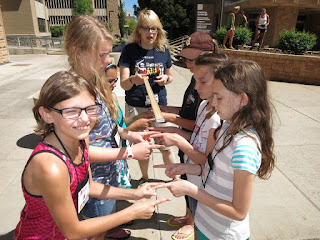Day 5
Thursday 18 June 2015
[ Sorry for the delay -- just got back from an awesome all-day trip to the Snowies with the campers ]
On Thursday we started out with our second round of paper rocket design
followed by the actual launches and the subsequent data analysis
(distance as a function of rocket mass, etc.). The
(graphed) results were consistent with a rocket mass of ~20-30 grams
providing the maximum distance traveled. After that we experienced 10 different ways astronauts might train for a space mission. After lunch the campers did some more spacecraft designing on the computer, and even printed out their designs on a 3D printer. They later tried their hand at climbing on our gym's new 3-story climbing wall. We also prepared
for our adventure to the nearby Snowy Range on Friday, a day where we will explore
different environments and take soil and water samples to be later
tested for signs of life.










































































